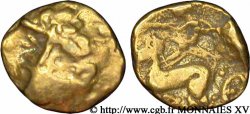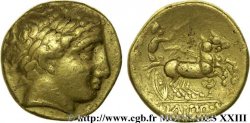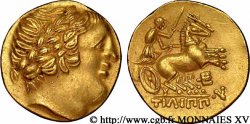- Accueil
- >
- >
v28_0685 - HELVETI (Current Switzerland) Statère de Philippe II, imitation celtique type de “Montmorot”
MONNAIES 28 (2007)
Начальная цена : 1 800.00 €
Назначить цену : 2 800.00 €
Цена реализации : 1 800.00 €
Количество ставок : 1
Максимальная предлагаемая цена : 1 960.00 €
Начальная цена : 1 800.00 €
Назначить цену : 2 800.00 €
Цена реализации : 1 800.00 €
Количество ставок : 1
Максимальная предлагаемая цена : 1 960.00 €
Тип Statère de Philippe II, imitation celtique type de “Montmorot”
Дата: IIe-Ier siècles avant J.-C.
Металл: gold
Диаметр: 19 mm
Ориентация осей монеты: 11 h.
Вес: 8,32 g.
Редкость: R3
Комментарии о состоянии
Statère centré sur un flan large et lourd. Le droit est de frappe molle et/ou frappé avec un coin usé. Le revers est légèrement décentré sur la droite. Un petit coup sur la tranche est à signaler, à 10 heures au revers
Ссылки в каталоге: :
Происхождение:
Ce statère proviendrait d’une collection familiale vendéenne
Лицевая сторона
Аверс: легенда: ANÉPIGRAPHE.
Аверс: описание: Tête laurée à droite, imitant la tête d’Apollon.
Обратная сторона
Реверс: Описание: Bige galopant à droite, les chevaux bondissant, avec un objet indéterminé sous les pattes avant ; l'aurige, au-dessus de la roue du char, tient un fouet ; traces de légende, mais pas de ligne d'exergue, avec un poisson (?) dessous.
Реверс: легенда: fILIPP.U.
Комментарий
Ce statère est une dégénérescence du type d'Abydos, avec l'épi de blé en différent au revers. L'attribution aux Helvètes est possible, mais pas certaine, pas plus que celle aux Arvernes ou bien encore une hypothétique attribution aux Carnutes. La concentration des trouvailles, pourtant dispersées, serait plutôt dans l'est de la France. Mais peut-on considérer qu'un seul peuple en est à l'origine....








 Cообщить об ошибке
Cообщить об ошибке Распечатать страницу
Распечатать страницу Отправить мой выбор
Отправить мой выбор Задать вопрос
Задать вопрос Consign / sell
Consign / sell
 Информация
Информация



